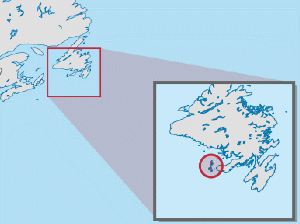| Territorial
Collectivity of Saint Pierre and Miquelon Departement de Saint-Pierre et Miquelon
 Location archipelago of
eight islands just off the southern coast of
Newfoundland, Canada Location archipelago of
eight islands just off the southern coast of
Newfoundland, Canada
 Total Area 93 sq mi
(242 sq km) Total Area 93 sq mi
(242 sq km)
Highest Point Morne de la
Grande Montagne; 787 ft (240 m)
Lowest Point sea level
Nationality
French
Population (July 2015 est) 5,657
Largest Cities Saint-Pierre
Ethnic Groups Basques, Bretons
Religions Roman Catholic
Languages French (official)
Capital
Saint-Pierre
Dependency Status self-governing
territorial overseas collectivity of France
Form of Government parliamentary
representative democracy
Present Constitution Adopted
October 4, 1958
Chief of State French President
Francois Hollande (since May 15, 2012);
represented by Prefect Jean-Christophe Bouvier
(since September 2014)
Head of Government President of
the Territorial Council Stephane Artano (since
March 31, 2006)
Legislature unicameral
Territorial Council (Conseil Territorial)
Judiciary Superior Tribunal of
Appeals (Tribunal Superieur d'Appel)
Local Administration none
Currency Euro
Per Capita Income $34,900
Principal Industries fish
processing and supply base for fishing fleets;
tourism
Agricultural Products vegetables;
poultry, cattle, sheep, pigs
Export Commodities fish
and fish products, soybeans, animal feed,
mollusks and crustaceans, fox and mink pelts
Import Commodities meat,
clothing, fuel, electrical equipment, machinery,
building materials
National Holiday
Fete de la Federation; July 14 (1789)
Origin of Name "Saint-Pierre"
is French for Saint Peter, the patron saint of
fishermen. "Miquelon" is believed to be
a Basque form of the name Michael.
Flag a yellow
three-masted sailing ship facing the hoist side
rides on a blue background with scattered, white,
wavy lines under the ship; a continuous
black-over-white wavy line divides the ship from
the white wavy lines; on the hoist side, a
vertical band is divided into three parts: the
top part (called ikkurina) is red with a green
diagonal cross extending to the corners overlaid
by a white cross dividing the rectangle into four
sections; the middle part has a white background
with an ermine pattern; the third part has a red
background with two stylized yellow lions
outlined in black, one above the other; these
three heraldic arms represent settlement by
colonists from the Basque Country (top),
Brittany, and Normandy; the blue on the main
portion of the flag symbolizes the Atlantic Ocean
and the stylized ship represents the Grande
Hermine in which Jacques Cartier
"discovered" the islands in 1536


France
Questions or comments about
this page?
|



